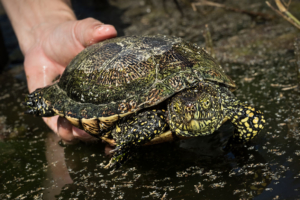This article has just been published in the journal Environmental Toxicology and Chemistry. This research examined the contamination of European pond turtles by persistent organic pollutants (POPs) in the Camargue.
You can access to it on the Tour du Valat web documentary portal.

Abstract: Many banned persistent organic pollutants (POPs) remain for decades in the aquatic environment and can have harmful effects on long-lived predators because of their high bioaccumulation and biomagnification potentials. We investigated the occurrence and levels of 18 polychlorinated biphenyls (PCBs) and 16 organochlorine pesticides (OCPs) in European pond turtles (n = 174) from April to July 2018 in the Camargue wetland, France. Although the Camargue was highly contaminated in previous decades, plasma occurrence and levels of POPs were very low: we were able to quantify only three of the 34 compounds we analyzed in more than 10% of the turtles. POP burdens did not differ between males and females and were uncorrelated with sampling date and body mass. We observed differences in POP burdens between turtles from the two sampling sites. One possible explanation is that the sampling sites were in different agricultural hydraulic system: plasma occurrence and levels were higher for PCB-52 and HCB in turtles captured in drainage channels, and for PCB-153 at the site that receives irrigation. Finally, the occurrence and levels of PCB 153 in turtles increased with age, likely because of bioaccumulation and much higher exposure 20-30 years ago than now.
Bibliographical reference: Burkart, L., Olivier, A., Lourdais, O., Vittecoq, M., Blouin-Demers, G., Alliot, F., Le Gac, C., Martin, N. and Goutte, A. (2021), Determinants of Legacy Persistent Organic Pollutant Levels in the European Pond Turtle (Emys orbicularis) in the Camargue Wetland, France. Environ Toxicol Chem. https://doi.org/10.1002/etc.5077